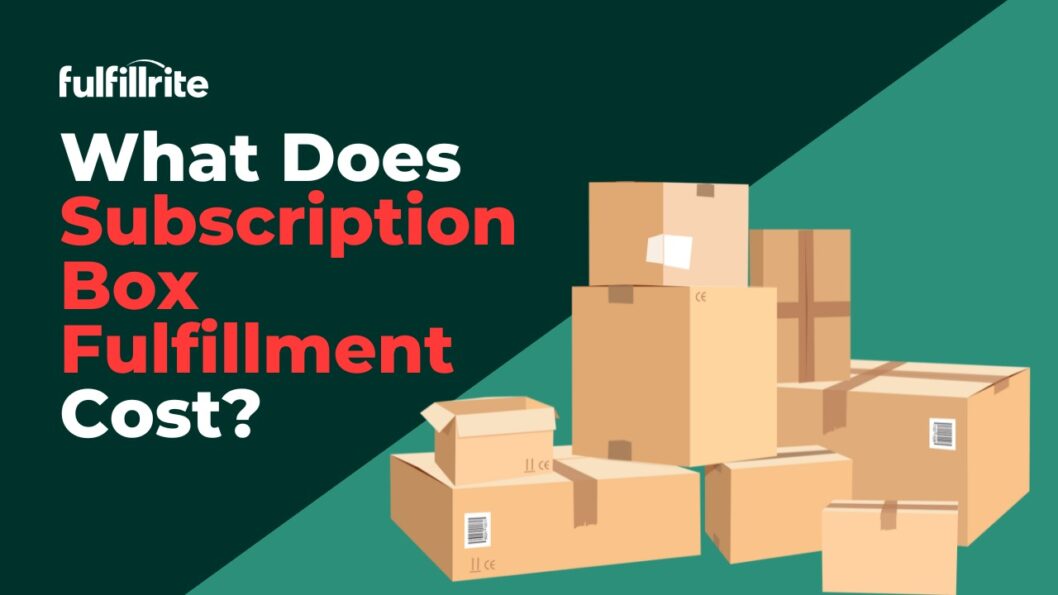You’ve built your box. Nailed your niche. Maybe even made your first few sales.
Now comes the hard part—actually shipping it.
Fulfillment is where the rubber meets the road. And if you’re not careful, it’s where your margins go to die. Between packing materials, labor, and postage, subscription box fulfillment cost can spiral fast—especially if you’re trying to do everything yourself.
But it doesn’t have to be a mystery. Once your product’s ready to go, a solid third-party logistics partner like Fulfillrite can take the load off.
But we’ll get to that later. First, let’s break down what you’re really paying for when you send a box out the door.
What goes into subscription box fulfillment cost?
The cost to fulfill a subscription box isn’t just about shipping. It’s a stack of smaller costs that add up fast.
Here’s what you’re really paying for:
1. Pick and pack labor
Someone has to physically grab your items off a shelf, assemble the box, and pack it securely. If your box has five items, that’s five touches. If one item’s fragile or requires special placement, add time. Time is money.
2. Packaging materials
Boxes. Inserts. Tissue paper. Branded stickers. Labels. Tape. Void fill.
It’s not just about what fits the items—it’s how it looks when the customer opens it. Subscription boxes live and die on presentation.
3. Postage and carrier fees
USPS, UPS, FedEx. They’re all the same in one key respect: cost depends on the weight, dimensions, and destination. Even an ounce over a threshold can spike your shipping rates.
4. Storage fees
If you’re using a fulfillment center, you’ll pay to store your products. Fees can be per pallet, bin, or cubic foot. The more SKUs you carry or the longer things sit, the more you’ll pay.
5. Kitting or assembly
Some fulfillment partners charge extra to pre-assemble boxes or pack them in a certain order. This is especially true for curated or seasonal boxes with a specific arrangement.
The subscription model creates some advantages, such as batch shipping which lets you plan ahead. But it also comes with unique timing demands.
You can’t just ship when an order comes in. You’ve got a drop date. That means coordinating production, inventory, and shipping on a tight schedule.
Bottom line: subscription box fulfillment cost isn’t one number. It’s a recipe with many ingredients.
How subscription box fulfillment costs change with volume and complexity
There’s good news and bad news here.
The good: your per-box cost usually goes down as your volume goes up. That’s basic economics. A fulfillment center can handle 500 boxes more efficiently than 50.
The bad: complexity cancels that out fast. Let’s look at a few examples.
50 identical boxes take less time to pack than 50 personalized ones. That’s because workers can go into batch mode. Same steps, same items, same setup.
Fragile or perishable items require extra care. Think bubble wrap, insulated packaging, even cold packs. All of that adds cost—not just in materials, but in handling time and potential spoilage risk.
Multi-item assortments can get tricky too. If each customer gets a random mix, that’s more decisions, more touches, and more room for error. Mistakes lead to returns. Returns cost money.
“I think that founders tend to forget to account for packing, inserts, and fulfillment in early pricing,” says Brian Kroeker, President at Little Rock Printing. “Use a basic cost – plus model but test price elasticity with early subscribers via A/B tests.”
One more hidden factor? Forecasting. If you overestimate demand, you’re paying to store unsold goods. If you underestimate, you might have to rush production, or worse, send boxes late. Either way, your costs go up.
This is where subscription box fulfillment cost gets slippery. Volume saves money. But only if your systems and product mix are dialed in.
In-house vs. outsourced fulfillment
Let’s be honest. Most people start off fulfilling boxes from home.
A spare bedroom becomes the warehouse. The dining table turns into a packing station. At the beginning, that’s fine—smart, even. You learn the ropes. You stay close to the product. You save cash.
But at some point, the math flips.
Your time starts to cost more than the postage you’re trying to save. Mistakes pile up. Returns eat your lunch. The living room fills with packing peanuts. That’s when it’s time to take a hard look at the real cost of in-house fulfillment.
Here’s a rough comparison:
In-house costs:
- Time (you or your team’s)
- Rent or lost living space
- Packing supplies
- Shipping software or manual printing
- Lost time on errors, returns, and customer service
Outsourced fulfillment costs:
- Per-order fees (usually includes pick, pack, label)
- Storage (charged monthly per bin or pallet)
- Shipping (usually discounted commercial rates)
- Optional services (kitting, returns, etc.)
The difference? Predictability.
To that point, Founder of Colourvistas, Hasan Hanif, says that “one of the most underestimated parts of a subscription box brand is the fulfillment logistics, as new brands tend to only focus on the product. The worst of them is the failure to plan on the operational aspect, such as inventory, shipping expenses, and timely delivery. Your reputation can be wounded within a moment by slower delivery or broken products.”
When you handle fulfillment yourself, the costs can be sneaky—especially the ones that hit you in lost time. With a third-party logistics provider (3PL), you pay a fixed fee per shipment, plus any add-ons you need.
It’s easier to budget. Easier to grow. Easier to sleep at night.
So when does outsourcing make sense?
A lot of brands make the switch around 150-200 boxes per month. That’s the tipping point where the labor, time, and room required starts to become a liability. If you’re doing that kind of volume—or aiming for it soon—it’s time to at least get quotes.
Fulfillrite is one of the few 3PLs that specialize in subscription box fulfillment. We don’t design your product, and we don’t curate what goes in the box—but once you’ve got that figured out, we handle everything from storage to final delivery. We even offer climate control, lot tracking, and seamless integrations with Shopify, Cratejoy, and others.
How to reduce subscription box fulfillment costs without cutting corners
Okay. So you understand what goes into fulfillment. You know when it makes sense to outsource. But how do you actually keep subscription box fulfillment cost under control?
Let’s talk about cost-saving strategies that don’t wreck your product or customer experience.
1. Use right-sized packaging.
Shipping air is expensive. If your box is too big, you’re paying extra on dimensional weight. Too small, and you risk damage or crammed presentation. Dial it in.
2. Batch your fulfillment.
Sending all your boxes at once saves time and money. If you’re shipping weekly or daily, consider shifting to a monthly cadence. Less chaos, better planning.
3. Automate where you can.
Inventory syncing, order imports, customer updates—these can all be automated. The more manual steps you cut out, the fewer chances there are for mistakes (and the faster fulfillment gets done).
4. Choose a 3PL with strong software integrations.
This matters more than people think. If your fulfillment partner integrates with your store, you don’t have to manually transmit orders or inventory updates. Fulfillrite integrates with major platforms like Shopify, WooCommerce, and BigCommerce out of the box. That saves you time, and by extension—money.
5. Prioritize accuracy and consistency.
Customer retention is more important than shaving a few cents per shipment. Messy packing, missing items, or late boxes cost you way more in churn than you’ll ever save with cheap tape.
It’s tempting to cut corners on fulfillment, especially when margins are tight. But the better path is smart optimization. Get the basics right, streamline the rest.
That’s how you build a subscription box business that lasts.
Final Thoughts
Subscription box fulfillment cost is more than just postage. It’s labor, materials, space, accuracy, and time. And whether you’re shipping 50 boxes or 5,000, those costs need to be managed—because they compound fast.
Start by understanding what you’re really paying for. Track your true per-box cost, including hidden time and labor. Then look for smart ways to improve: better packaging, batch fulfillment, automation, and when you’re ready—outsourcing.
If you’re thinking about that next step, Fulfillrite can help. We’re a fulfillment partner that works with subscription box companies every day. If your products are ready to ship and you’re starting to feel stretched thin, we’ll help you ship smarter so you can focus on growth.

